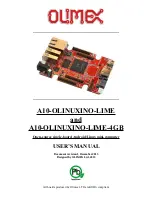
ISD91200 Series Technical Reference Manual
Release Date: Sep 16, 2019
- 391 -
Revision 2.4
Figure 4. Block diagram of instrumentation amplifier (IA).
7.2.4
Operation
7.2.4.1
Startup
To power on the bridge sense part of the I92160B the bridge sense bandgap and the LDO have to be
turned on first.
To charge the external filter capacitor connected to pins VBG and VSSA faster bit BFLTCHRG of
BS_BANDGP_LDO has to be set high. This bit can be set low 2ms after starting the bandgap.
The output voltage of the LDO can be set before or after the LDO is turned on.
To ensure that the noise of the LDO is cancelled out the VMID Reference Generator has to be turned
off (see section
Error! Reference source not found.
) and bit DIVEN in register BS_BANDGAP_LDO
has to be enabled.
After that the instrumentation amplifier (IA) and the SDADC can be enabled.
See section
Error! Reference source not found.
on how to set the output sample rate of the SDADC.
7.2.4.2
Choppers
The bandgap has nested choppers around the opamp to reduce the effect of its offset and 1/f noise on
the bandgap output. The chopping frequencies can be adjusted and the choppers can also be turned
off. The low frequency chopper enable bit (BCHOPLFEN) in register BS_BANDGPLDO can be set high
while BCHOPEN is low, but the low frequency chopper will only function when BCHOPEN is set high.
The instrumentation amplifier also has two sets of choppers, one set running at a high frequency and
one running at a low frequency. For the low frequency chopper the demodulation has to be done by
software. See Figure 4.
As with the bandgap the chopper frequencies can be adjusted.
7.2.4.3
Ripple Trim Instrumentation Amplifier
The purpose of the choppers in the instrumentation amplifier (IA) is to prevent that the offset and the 1/f
noise of the opamps are added to the signal. This is done by moving the offset and 1/f noise to the
chopper frequency. If the gain of the IA is set high the resulting ripple will reduce the input voltage
window of the IA. To reduce this impact, the offset of the input opamps in the IA can be trimmed. To do
this, the IA can be set in the offset trimmode, by setting bit OFFSETTRIM in register BS_INSTRAMP
high.
In the offset trim mode the input of the IA is shorted and connected to the 1.5V supply. The choppers of
the two input opamps can be turned off and on independently and when a chopper is off its phase can
be changed as well. Changing the chopper phase of one of the input opamps should change the output
value of the sigma delta converter. This change in output value is a measure of the offset of that opamp
and should be minimized by adjusting the appropriate OFFSET bits in the register BS_INSTRAMP.



































